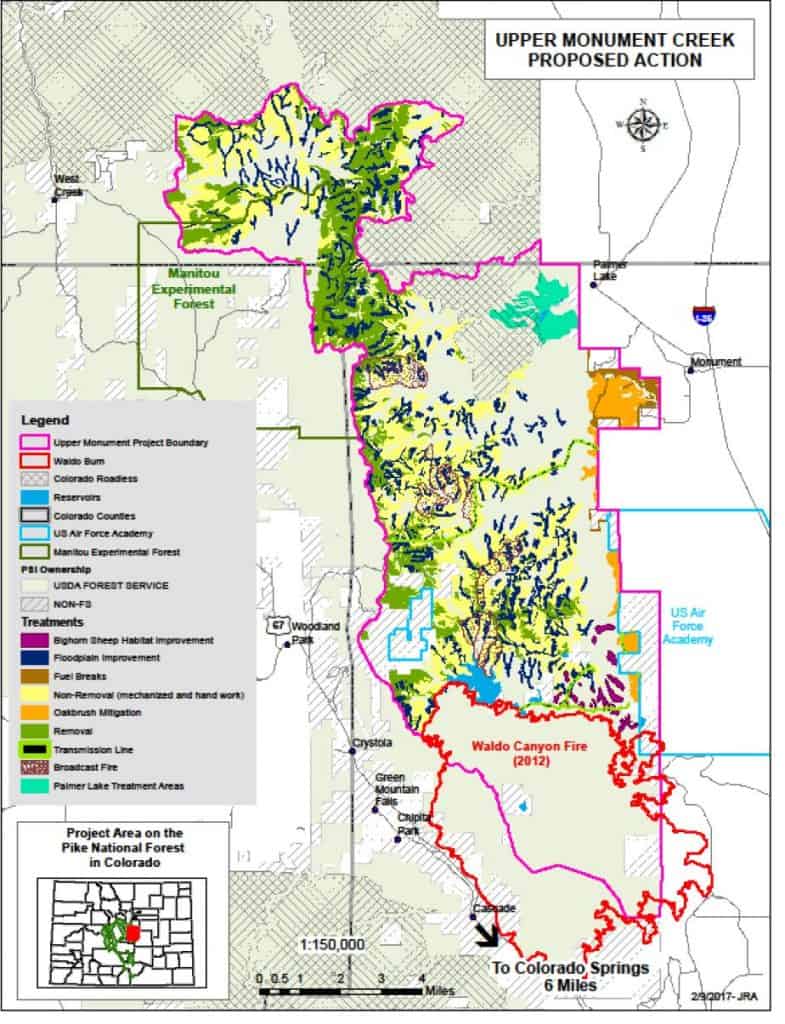As the Forest Service pursues improvements in Environmental Analysis and Decision Making through the EADM effort, it would be helpful to take a look at successful landscape scale projects and see if we can discern what they have in common. Certainly there is also shared learning on this topic going on within the agency, but this is an opportunity for those of us looking in from outside to see what makes for success, and perhaps give that as feedback to the process somewhere along the line.
Please submit posts on different successful (defined by you) projects to my email on the widget to the right. FS employees are encouraged to do so as well and I do not have to share the name of the contributor.
Here is my first candidate: the Upper Monument Creek on the PSICC National Forest in Colorado.
Here’s a description from the ROD of the project.
The intent of the proposed action is to restore more resilient ecological conditions across the entire landscape and particularly Front Range forests; reduce the impacts of severe wildfires on property, infrastructure, and natural resources; and contribute towards the long-term sustainability of a full range of forest values including creating effective wildlife habitat and protecting aquatic resources. The proposed action entails the treatment of up to 31,700 acres within the 70,600-acre UMC project area (Figure 4). A combination of mechanical thinning with product removal, service work, manual thinning, pile burning, post treatment broadcast burning, and first entry prescribed fire would be utilized to achieve the desired ecological conditions. Implementation of these management actions is expected to begin in 2017, and extend over a period of 10 years or more.
Acres treated: 31,700/70,600
NEPA tool: EIS
Collaboration: CFLRP
Time to prepare: 2012-2017
Time to conduct treatments: 10 or more years
Objections: 1
Litigation:0
I asked the District Ranger, Oscar Martinez, why he thought this approach was successful. Here’s his answer:
Given the nature of the objection, I still saw this as a victory for the IDT because we certainly had a large following of partners that were tracking the decision. To be honest, the process still took some time, but as the saying goes,… it is often necessary to go slow to go fast at the end. For us this translated into spending the time upfront in building a strong coalition with a wide range of partners that were fully vested in the process and the final objectives for the project. Consequently, the majority of the team’s time was spent in building the understanding and trust needed to support a decision that took full advantage of scale, complexity, and adaptive management principles to achieve those objectives. As we proceed with implementation, we expect that many of these partners will remained supportive and interested as we test our restoration assumptions.
The nature of the one objection is that it is pretty generic and from a person who objects or appeals a wide variety of things across the country. In my experience, this same person is not so much into the specifics of the project and makes a variety of what I would call “unsubstantiated knowledge claims.”
But you can check the objection out for yourself 20170618_UMC_obj_artley.
Note: I have seen some objections posted publicly and others not, depending on the project. If FS people can chime in whether the national database is gone, or what exactly is going on, that would be helpful. They are part of the puzzle.
